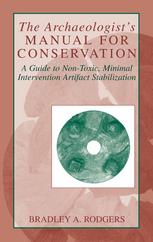

Most ebook files are in PDF format, so you can easily read them using various software such as Foxit Reader or directly on the Google Chrome browser.
Some ebook files are released by publishers in other formats such as .awz, .mobi, .epub, .fb2, etc. You may need to install specific software to read these formats on mobile/PC, such as Calibre.
Please read the tutorial at this link: https://ebookbell.com/faq
We offer FREE conversion to the popular formats you request; however, this may take some time. Therefore, right after payment, please email us, and we will try to provide the service as quickly as possible.
For some exceptional file formats or broken links (if any), please refrain from opening any disputes. Instead, email us first, and we will try to assist within a maximum of 6 hours.
EbookBell Team

5.0
20 reviewsThis is a Foreword by an archaeologist, not a conservator, but as Brad Rodgers says, “Conservation has been steadily pulled from archaeology by the forces of specialization”(p. 3),andhewantstoremedythatsituationthroughthismanual. He seesthisworkasa“calltoactionforthenon-professionalconservator,”permitting “curators, conservators, and archaeologists to identify artifacts that need prof- sional attention and, allow these professionals to stabilize most artifacts in their own laboratories with minimal intervention, using simple non-toxic procedures” (p. 5). It is the mission of Brad’s manual to “bring conservation back into arch- ology” (p. 6). The degree of success of that goal depends on the degree to which archaeologists pay attention to, and put to use, what Brad has to say, because as he says, “The conservationist/archaeologist is responsible to make preparation for an artifact’s care even before it is excavated and after its storage into the foreseeable future”. . . a tremendous responsibility” (p. 10). The manual is a combination of highly technical as well as common sense methods of conserving wood, iron and other metals, ceramics, glass and stone, organicsandcomposits—afarbetterguidetoartifactconservationthanwasava- able to me when I ?rst faced that archaeological challenge at colonial Brunswick Town, North Carolina in 1958—a challenge still being faced by archaeologists today. The stage of conservation in 1958 is in dramatic contrast to the procedures Brad describes in this manual—conservation has indeed made great progress. For instance,acommonprocedurethenwastoheattheartifactsredhotinafurnace—a method that made me cringe.